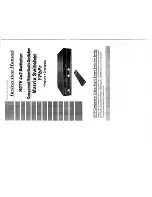
3
1.4. Dimensions and fitting of the
PSB-48V5A power supply.
2. Installation.
2.1. Requirements.
PSU is to be mounted by a qualified installer, holding relevant permits and licenses (applicable and required for a
given country) for low-voltage installations. The device shall be mounted in closed rooms, according to the environment
class II, of the normal air humidity (RH=90% max. without condensation) and the temperature within the range from -
10°C
to +40°C.
The power supply shall be mounted in a close casing (a cubicle, a terminal device) and in order to fulfill LVD and
EMC requirements the rules for power-supply, encasing and shielding shall be observed according to application.
Due to the power supply design, the protection wire has to be connected to the corresponding connector of the
supply unit. Before installation, prepare a PSU load balance with point 1.1.
2.2. Installation procedure.
Before installation, make sure that the voltage in the 230 V power-supply circuit is cut off. To switch off
power use an external switch in which the distance between the contacts of all poles in the
disconnection state is not less than 3mm.
1. Mount the PSU in a selected location and connect the wires.
2. Connect the power cables (~230 V) to L-N clips of the PSU.
The shock protection circuit shall be performed with a particular care, i.e. the yellow and green wire
coat of the power cable shall stick to one side of the ‘
’ terminal - in the PSU enclosure. Operation of
the PSU without a properly made and fully operational shock protection circuit is UNACCEPTABLE! It
can cause a device failure or an electric shock
.
3. Connect the ground wire to the clip marked by the earth symbol
(
connector of power supply module). Use a three-
core cable (with a yellow and green protection wire) to make the connection. Lead the cables to the appropriate clips of
the subplate through the insulating bushing.
4. Check the PSU output voltage, if needed correct the setting it should by the potentiometer.
5. Connect load / loads to proper output connectors of the power supply (positive end is marked as +V, negative
end as V-)
6. Screw the battery cables to the BAT connector
(black B-, red B +).
7. Connect the battery in series paying attention to polarity.
8. Connect the PKAZ168 external optical signalling
(optional equipment)
9. Once the tests and control operation have been completed, close the
enclosure/cabinet.






















